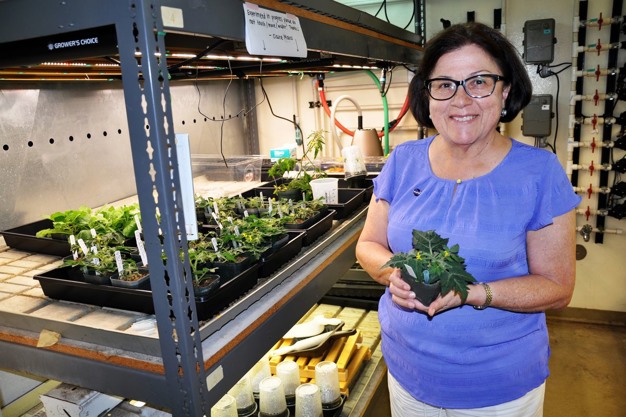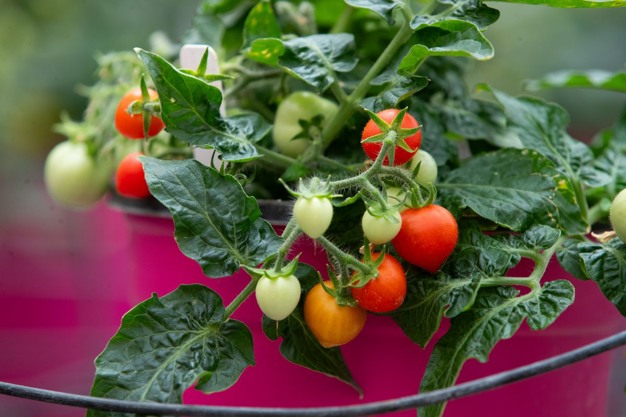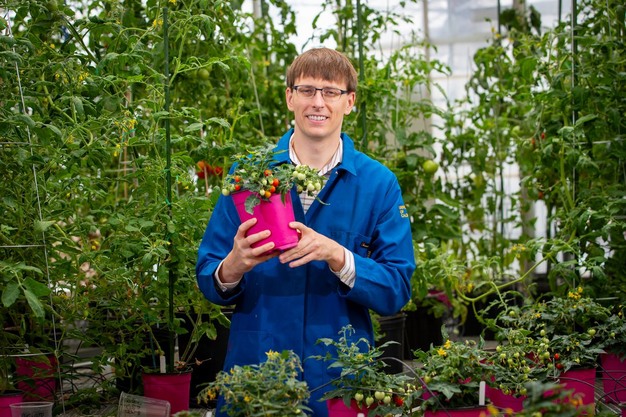The first space-grown tomatoes are estimated to be harvested early to mid-2025. "We're currently in the process of finalizing our experiment development plan with NASA," says Martha L. Orozco-Cardenas, Ph.D., director of the Plant Transformation Research Center at the University of California, Riverside.
"Our goal is to launch the tomatoes during Advanced Plant Habitat Mission 08 (APH08)," said Orozco-Cardenas, who collaborated with Associate Professor Robert Jinkerson to develop the tomato.
After Romaine lettuce, tomatoes are the second vegetable item grown in space. Romaine lettuce was cultivated on the International Space Station (ISS) in 2015 as part of NASA's Veggie experiment.

Martha Orozco-Cardena holds a blossoming tomato plant in the laboratory. Photo: David Danelski.
Benefits of tomatoes in space
For more than five years, UCR has been working on the development of a tomato variety that is suitable to be grown in space. "Having tomatoes in space is extremely valuable," shared Orozco-Cardenas. "They are so rich in essential nutrients, making them an excellent choice for maintaining a healthy diet. In addition, tomatoes offer psychological benefits by enhancing mood and reducing stress through the sensory experience of fresh, flavorful food, providing comfort and a sense of normalcy in isolated environments like space."
Furthermore, tomatoes are a crucial model organism in scientific research due to their well-characterized genome, making them ideal for studying gene expression under earth's gravity and microgravity. "They are also amenable to gene-editing techniques such as CRISPR-Cas9, as demonstrated by the results seen in our space tomatoes." These advances contribute significantly to crop improvement and broader plant biology research.

Plant with ripe space tomatoes. Photo: Stan Lim.
Traits of space tomatoes
Compared to their wild-type counterparts, tomato plants suitable for space are shorter, but produce the same fruit yield, with less variability in fruit size. In other words, there is reduced green vegetative growth and a greater emphasis on consistently producing edible fruit. "These traits are worth further research to support a new wave of agriculture focused on maximizing growth space, especially as earth's arable land decreases and the impacts of climate change intensify," commented Orozco-Cardena.
"Vining tomato varieties pose significant challenges for indoor vertical farming due to their unruly growth, the high level of intervention required (such as pruning), and their substantial vertical space demands," she commented. Consequently, the industry is shifting towards developing smaller plants that yield more fruit while occupying less space. The time between planting and harvest is similar to a regular tomato, but occasionally, researchers observe a faster flowering time for space tomatoes.

Associate Professor Robert Jinkerson showing space tomatoes in the greenhouse. Photo: Stan Lim.
Mushrooms
In addition to tomatoes, the UC Riverside team is also working on the development of a system to grow edible mushrooms in space. This summer, under leadership of Associate Professor Jinkerson, the team won $250,000 toward their research as a runner up in NASA's Deep Space Food Challenge. It is an international competition that started with about 200 teams of scientists to develop systems to produce food on the International Space Station. The proposed technology was limited to two cubic meters and could use no more than 1,500 watts of electricity. The system is estimated to generate about 4,000 calories per day.
Click here for more background information.
 For more information:
For more information:
Martha L. Orozco-Cardenas, Ph.D.
UC Riverside
martha.orozco-cardenas@ucr.edu
David Danelski
David.danelski@ucr.edu
www.ucr.edu
